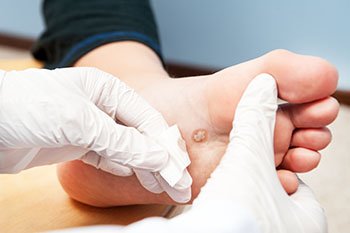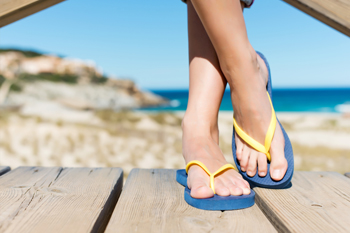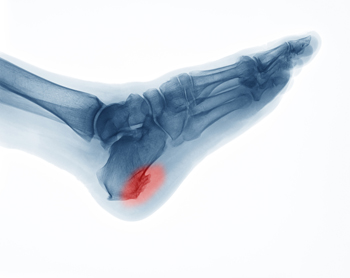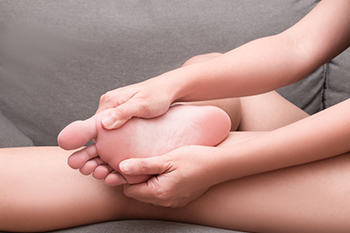Blog
Items filtered by date: July 2021
Flip-Flops and Your Gait
Flip-flops may be the most popular footwear of the summer, but that doesn’t mean that flip-flops are good for your foot health. While they may keep your feet cool, flip-flops can also alter your gait, or walking pattern. When you wear flip-flops, you typically need to scrunch up your toes around the ends of the shoes in order to keep them on. This can stretch the plantar fascia ligament that runs along the bottom of the foot and lead to heel and arch pain and plantar fasciitis. Another thing you might be doing to keep those flip-flops on your feet is walk with shorter strides and turn your ankles inward while you walk. This altered gait can cause long term ankle and hip problems. This summer, if you must wear flip-flops, choose ones made of a sturdier material and wear them infrequently. For more information about the effects of footwear on your feet, please consult with a podiatrist.
Flip-flops are not always the best choice of footwear. If you have any concerns about your feet or ankles, contact one of our doctors from Favor Foot Ankle Leg & Wound Center. Our doctors will assist you with all of your foot and ankle needs.
Flip-Flops and Feet
When the weather starts warming up, people enjoy wearing flip-flops. Flip-flops are comfortable, stylish, and easy to slip on and off; they're perfect for any summer beach goer. However, these shoes can cause harm to the feet.
How Can Flip-Flops Affect Me Long-Term?
- Ankle problems
- Hip problems
- Lower back problems
- Pain in the balls of the feet
- Problems with foot arches
- Changes in the way you walk
Are There Injuries Associated with Flip-Flops?
Yes. Since flip-flops are relatively weak and do not provide the same amount of support as sneakers, people who wear flip-flops regularly are more susceptible to injuries. On top of that, the open nature of the shoe makes your feet more prone to other problems, such as cuts and even infections. Common injuries and ailments include:
- Sprained ankles
- Blisters
- Infections
- Cuts and Scrapes
I like Wearing Flip-Flops. Are There Safe Alternatives?
When buying flip-flops, try to find ones that have sturdy soles and that are made of high-quality materials that will support for your feet. These flip-flops will cost more but will also last longer as a result.
If you have any questions please feel free to contact our office located in South Amboy, NJ . We offer the newest diagnostic and treatment technologies for all your foot and ankle needs.
Does It Hurt to Freeze a Foot Wart?
 Plantar warts, which grow on the bottom of the feet, can be removed by freezing them off in a treatment called cryotherapy. During this procedure, the doctor cuts the wart with a small, sharp knife and then applies a freezing substance, such as liquid nitrogen, with a cotton swab or spray. Cryotherapy can hurt, and your doctor may use a local anesthetic to reduce pain. The treatment itself takes only a few minutes. Following the procedure, your foot may hurt for two to three days. A blister can form over the site of the wart but will typically disappear within a few days. There is a chance for minimal scarring. If you have a wart on the bottom of your foot, it is suggested that you consult a podiatrist to see if cryotherapy is the right treatment for you.
Plantar warts, which grow on the bottom of the feet, can be removed by freezing them off in a treatment called cryotherapy. During this procedure, the doctor cuts the wart with a small, sharp knife and then applies a freezing substance, such as liquid nitrogen, with a cotton swab or spray. Cryotherapy can hurt, and your doctor may use a local anesthetic to reduce pain. The treatment itself takes only a few minutes. Following the procedure, your foot may hurt for two to three days. A blister can form over the site of the wart but will typically disappear within a few days. There is a chance for minimal scarring. If you have a wart on the bottom of your foot, it is suggested that you consult a podiatrist to see if cryotherapy is the right treatment for you.
Plantar warts can be very uncomfortable. If you need your feet checked, contact one of our doctors from Favor Foot Ankle Leg & Wound Center. Our doctors will assist you with all of your foot and ankle needs.
About Plantar Warts
Plantar warts are the result of HPV, or human papillomavirus, getting into open wounds on the feet. They are mostly found on the heels or balls of the feet.
While plantar warts are generally harmless, those experiencing excessive pain or those suffering from diabetes or a compromised immune system require immediate medical care. Plantar warts are easily diagnosed, usually through scraping off a bit of rough skin or by getting a biopsy.
Symptoms
- Lesions on the bottom of your feet, usually rough and grainy
- Hard or thick callused spots
- Wart seeds, which are small clotted blood vessels that look like little black spots
- Pain, discomfort, or tenderness of your feet when walking or standing
Treatment
- Freezing
- Electric tool removal
- Laser Treatment
- Topical Creams (prescription only)
- Over-the-counter medications
To help prevent developing plantar warts, avoid walking barefoot over abrasive surfaces that can cause cuts or wounds for HPV to get into. Avoiding direct contact with other warts, as well as not picking or rubbing existing warts, can help prevent the further spread of plantar warts. However, if you think you have developed plantar warts, speak to your podiatrist. He or she can diagnose the warts on your feet and recommend the appropriate treatment options.
If you have any questions please feel free to contact our office located in South Amboy, NJ . We offer the newest diagnostic and treatment technologies for all your foot and ankle needs.
Get Professional Care for a Broken Foot or Ankle
Are Heel Spurs Problematic?
Heel spurs are bony growths that develop around the heel bone, typically in response to injury over time. On their own, heel spurs are thought to be asymptomatic. Often, people only know they have a heel spur because it was found incidentally on an X-ray. Nevertheless, while they are not as likely to cause pain on their own, heel spurs are associated with certain painful foot conditions, such as plantar fasciitis. If you are experiencing heel pain, it is suggested that you see a podiatrist. This medical professional can diagnose your heel pain and offer effective treatments to relieve your symptoms.
Heel spurs can be incredibly painful and sometimes may make you unable to participate in physical activities. To get medical care for your heel spurs, contact one of our doctors from Favor Foot Ankle Leg & Wound Center. Our doctors will do everything possible to treat your condition.
Heels Spurs
Heel spurs are formed by calcium deposits on the back of the foot where the heel is. This can also be caused by small fragments of bone breaking off one section of the foot, attaching onto the back of the foot. Heel spurs can also be bone growth on the back of the foot and may grow in the direction of the arch of the foot.
Older individuals usually suffer from heel spurs and pain sometimes intensifies with age. One of the main condition's spurs are related to is plantar fasciitis.
Pain
The pain associated with spurs is often because of weight placed on the feet. When someone is walking, their entire weight is concentrated on the feet. Bone spurs then have the tendency to affect other bones and tissues around the foot. As the pain continues, the feet will become tender and sensitive over time.
Treatments
There are many ways to treat heel spurs. If one is suffering from heel spurs in conjunction with pain, there are several methods for healing. Medication, surgery, and herbal care are some options.
If you have any questions feel free to contact our office located in South Amboy, NJ . We offer the latest in diagnostic and treatment technology to meet your needs.
Sesamoid Bones and Injuries
The sesamoids are two small, pea-shaped bones found just under the base of the big toe. The sesamoids are embedded in a tendon, allowing you to move the big toes and acting as shock absorbers in the foot while you walk and run. Though these bones are quite small, they can be easily injured. The area around the sesamoid bones may become inflamed due to injury or overuse, leading to sesamoiditis. Over time, these bones may become unable to bear the load placed on them and could even develop tiny stress fractures. A sudden injury to the bones can cause them to fully fracture. If you have pain, swelling, or bruising in the ball of your foot, schedule an appointment with a podiatrist who can diagnose and treat various sesamoid injuries.
Sesamoiditis is an unpleasant foot condition characterized by pain in the balls of the feet. If you think you’re struggling with sesamoiditis, contact one of our doctors of Favor Foot Ankle Leg & Wound Center. Our doctors will treat your condition thoroughly and effectively.
Sesamoiditis
Sesamoiditis is a condition of the foot that affects the ball of the foot. It is more common in younger people than it is in older people. It can also occur with people who have begun a new exercise program, since their bodies are adjusting to the new physical regimen. Pain may also be caused by the inflammation of tendons surrounding the bones. It is important to seek treatment in its early stages because if you ignore the pain, this condition can lead to more serious problems such as severe irritation and bone fractures.
Causes of Sesamoiditis
- Sudden increase in activity
- Increase in physically strenuous movement without a proper warm up or build up
- Foot structure: those who have smaller, bonier feet or those with a high arch may be more susceptible
Treatment for sesamoiditis is non-invasive and simple. Doctors may recommend a strict rest period where the patient forgoes most physical activity. This will help give the patient time to heal their feet through limited activity. For serious cases, it is best to speak with your doctor to determine a treatment option that will help your specific needs.
If you have any questions please feel free to contact our office located in South Amboy, NJ . We offer the newest diagnostic and treatment technologies for all your foot and ankle needs.
Blog Archives
- July 2025
- June 2025
- May 2025
- April 2025
- March 2025
- February 2025
- January 2025
- December 2024
- November 2024
- October 2024
- September 2024
- August 2024
- July 2024
- June 2024
- May 2024
- April 2024
- March 2024
- February 2024
- January 2024
- December 2023
- November 2023
- October 2023
- September 2023
- August 2023
- July 2023
- June 2023
- May 2023
- April 2023
- March 2023
- February 2023
- January 2023
- December 2022
- November 2022
- October 2022
- September 2022
- August 2022
- July 2022
- June 2022
- May 2022
- April 2022
- March 2022
- February 2022
- January 2022
- December 2021
- November 2021
- October 2021
- September 2021
- August 2021
- July 2021
- June 2021
- May 2021
- April 2021
- March 2021
- February 2021




